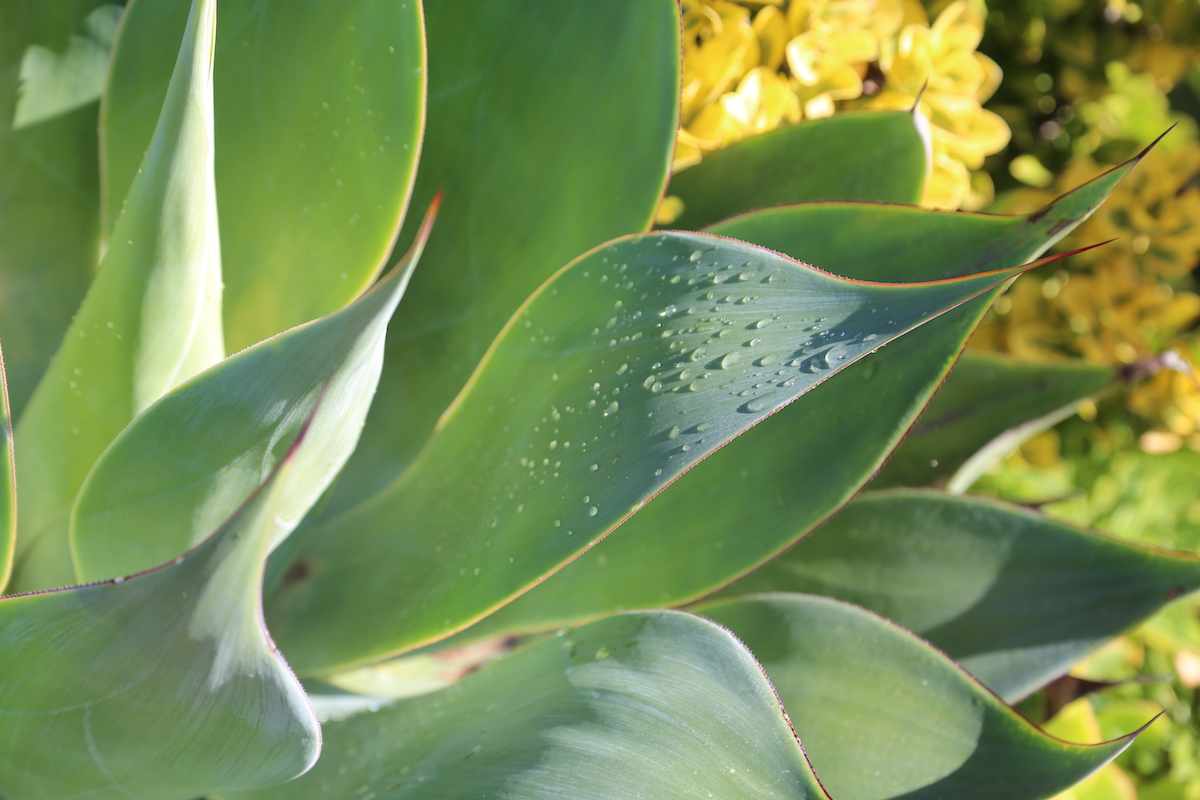
How Rain Benefits Succulents

Don't be surprised if after a good rain, your succulents look brighter and more vibrant. Here's how rain benefits succulents: It provides dissolved minerals and washes away dust that inhibits photosynthesis; it dilutes and flushes salts and harmful chemicals that have built up in the soil from tap water; and it provides nitrogen essential to growth, especially during electrical storms. It's odd but true: Lightning nourishes plants.
To make the most of precious rain, collect it in buckets and use it to water house plants and in-ground succulents beneath eaves. When rain is forecast, move your container-grown patio plants where rain can soak them. (Once the storm is over, return them to their earlier location, lest sun scorch leaves---or if frost is a possibility.)
Succulents do best in regions where annual rainfall is less than 25 inches. Excessive amounts can cause roots to rot, especially if soil stays soggy. Prepare for this by growing the plants in coarse, fast-draining soil, on a slope or atop a berm.

My blog post, Succulents and Too Much Rain, A French Solution describes a French botanical garden's simple but effective method of protecting its cactus collection.
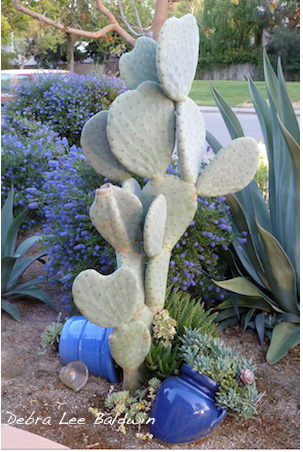
Of all succulents, cacti seem to respond the most dramatically to rain. No surprise; they've been waiting all year for it. If they weren't rooted, they'd be dancing. Opuntia (paddle) cacti that have been doing a whole lot of nothing for months rapidly grow new pads that can double the size of a young specimen in a matter of weeks. It's as though the pads were water balloons being squeezed; the resulting bulge is a new leaf.
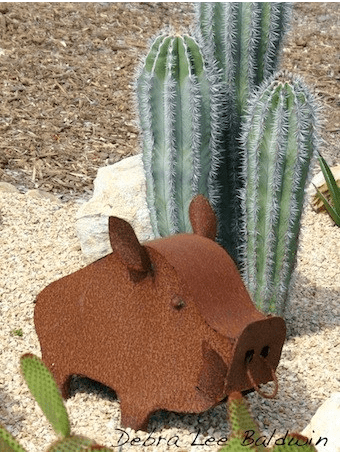
And then there are ribbed cacti...those that look like round or columnar accordions. You can almost hear their crenellations pop and stretch as they plump with water. They're such simple plants---not much more than balls or bats---and yet the way they grow is amazing. The process of becoming engorged with rainwater exposes more of their skin to the sun, enabling photosynthesis, which equals energy, which in turn fuels new growth. In the heat of summer, those same ridges and valleys deepen, shading and protecting the plant.
Now that succulents are hugely popular, I'm asked how to grow them in tropical climates that have a great deal of rainfall. It's like asking how to grow monkeys in Alaska. Sure it's possible, but is it worth it? By definition, succulents have the quality of succulence: juiciness. They're expressly designed to get by without a lot of rainfall. The flip side is that they don't survive well with it. So grow them in containers, and move them under shelter when the weather turns too wet. Even then, in humid climates, they may mildew. In which case, move them indoors, provide lots of sunlight and fresh air, and keep a dehumidifier going. (And get my book, Succulent Container Gardens. I wrote it for succulent lovers in challenging climates.)
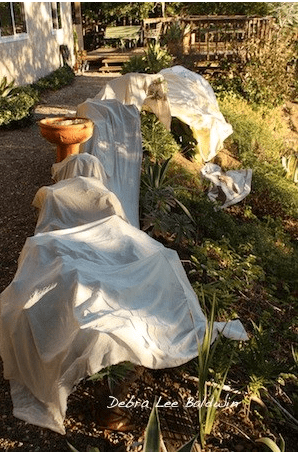
Rainstorms are often followed by clear, windless nights, during which the temperature may drop near freezing or below. Many succulents are frost tender, meaning that at 32 degrees, the water in their tissues crystallizes, expands, and bursts cell walls. This can turn leaves to putty, irreparably damaging the plants. You can gain several life-saving degrees by covering your succulents with sheets, lightweight fabric, or frost cloth. But not plastic, which by trapping moisture and blocking light and air can cause more damage than it prevents.
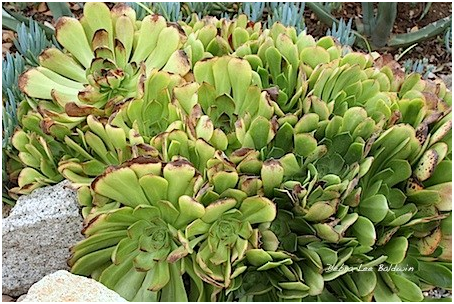
If your succulents have been damaged by frost, they're not necessarily goners. Learn more about this in my recent posts: Oh, No, My Succulents Froze! and Frost Damaged Succulents? Here's What to Do. Notice the damaged tips on these aeoniums? No need to do anything. In a few months the older leaves will dry and fall off, and the rest will be hidden by new growth.
Related info
On this site:
How to Water Succulents These fleshy-leaved plants from hot, dry regions are designed to live off water stored in their leaves and tissues in order to survive periods without rainfall. But this doesn't mean you shouldn't water them at all...[Continue reading]
Learn about pumice. No other soil amendment is as widely used by succulent growers and collectors as pumice (crushed lava rock). Here’s why...[Continue reading]
Succulents and Too Much Rain, A French Solution Want to protect your succulents from too much rain? Here's how the Jardin Zoologique Tropical in southeastern France...[Continue reading]
Oh, No, My Succulents Froze! Will succulents recover from frost damage? It depends. Here’s how frost-tender succulents looked before temps dropped into the mid-20s F, and after...[Continue reading]
Caring for Your Succulent Garden After Rainstorms, Checklist Rain at last! Could the California drought finally be over? Well, no. It’ll take hundreds of years for underground aquifers...[Continue reading]
Winter Protection for Succulents: Products Soggy soil, dim light, high humidity and freezing temperatures can be death to succulents native to warm, arid climates. These items will help you get your succulents through cold, wet North American winters...[Continue reading]
On My YouTube channel:
The Squish Test for Succulents
Why Succulents Rot and How to Prevent It

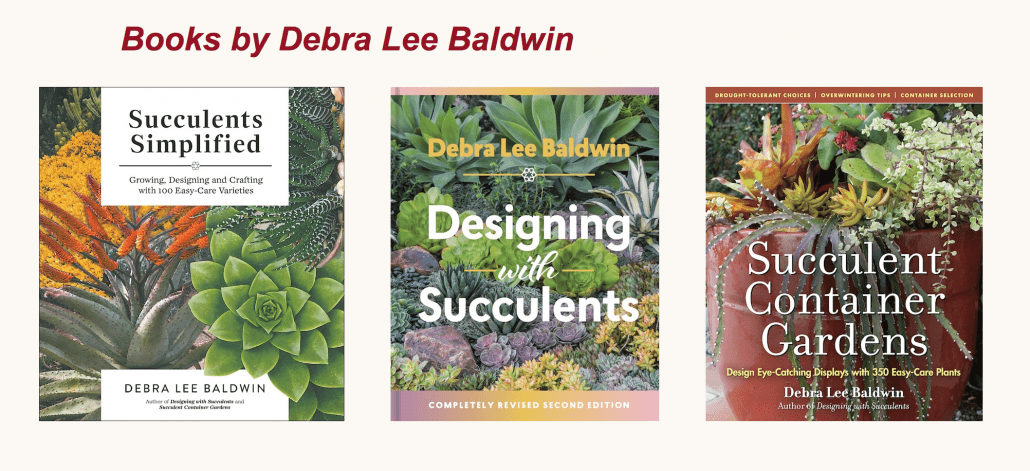
I live in Henderson, Nv..have cactus,succulents and drought tolerant plants in my garden..no grass ! Always looking for new ideas and new plants to add to what I have. Looking forward to your newsletter.
I’ve just gotten excited about succulents! Whole Foods had a sale(every plant was marked down to retail), so I bought several flats. We’ve had 4years of drought in N Calif. with decent rainfall last winter, but don’t know what to expect this winter. I plan on leaving them in the backyard facing South and if we get drenched, bring them in for a few days. Ok? Thanks for your help.
Paul
Hi Paul, It really depends on what kinds of plants they are. I wouldn’t bring them indoors in winter unless they might be killed by frost. If excessive rain is a concern, simply move them beneath an eve or patio overhang.
I live in San Francisco and we are in our rainy season. My wine barrel planters took a beating last winter. Any thoughts on what to cover them with during the back to back rainy days ? I️ don’t have a patio or anything to protect them with. But don’t wanna leave them out to potentially get rot ir just plain beat up.
My small succulent plant got bulged kind with water may be due to rainfall for past 3 days and I forgot to take it.It’s soft and tender..giving plastic touch feel..It even smelling foul kind.Please tell me what I can do..Please.. Please..
If it’s to the point that it smells bad, rot has set in, and nothing can be done. Discard plant and soil and start over.
I live in s.f. It’s winter and I plan on putting some of my succulents under an umbrella on my uncovered deck . It’s my fiirst year with my succulent collection. My deck faces the west southwest . Quite sunny in summer, decent sun in winter. Let’s talk about our succulents and share info.
Yes, let us know how well it works!
We’ve had two full days of rain and I left my succulents out for the rain. Now they are getting full sun and a nice breeze. I am only giving them one or at the most two rainy events for the whole winter. They look good so far.
Hi Everyone,
For about 15 years in Berkeley, I’ve had various amounts of rainfall on my sizable collection in the ground and in containers. As long as the soil drains (pumice/sand) well, I’ve only had a few casualties. Aeoniums and crassulas survive excess water the best. I’ve lost some gasterias and echeverias to rot. Surprise hail storms do more damage than El Nino. I just watch my prize specimens in containers and I will from time to time rotate a few from uncovered areas to my covered porch.
In order to perk up the indoors during rainy season, I do bring in a few pots for less than 2 weeks each to put around the house (mantle, dining room table) and this dries them out completely.
Heji
Hi, Debra,
I decided to immerse myself in gardening during this pandemic. Part of the garden consists of small potted succulents. Should I move them under an awning during our SF Bay Area rainy season?
Thank you,
Lynn
Hi Lynn — Yes, but let them get a good drenching first. Rainwater has dissolved nitrogen and minerals that are beneficial, and that are not necessarily available from other sources.
[…] alegría de las suculentas” Los temas incluyen Macetas suculentas para alféizar de ventana DIY, Cómo la lluvia beneficia a las suculentas, Cómo cultivar suculentas en interioresy El secreto de las suculentas felices. También llevo a […]